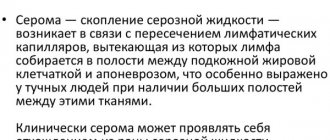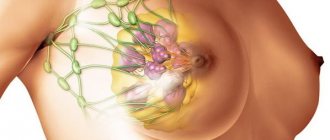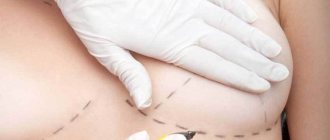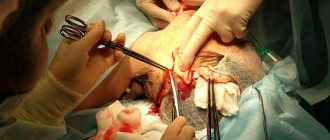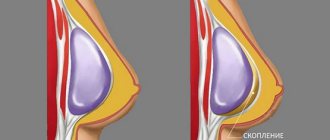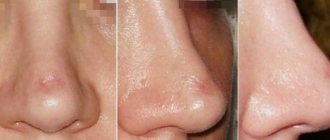Seroma is a cavity with serous fluid that forms in the area of a postoperative suture or after severe injury to soft tissues and blood vessels. It is not dangerous, often resolves on its own, but often requires therapy.
The first symptom of seroma is redness of the area around the suture and swelling, and the release of yellowish fluid along the edges of the wound. Additionally, the body temperature may rise, the patient is bothered by severe pain and a feeling of fullness and heaviness.
Treatment of seroma is carried out with medications or through the installation of drainage and vacuum aspiration. When diagnosing the problem early, it is advisable to use folk remedies - aloe compresses, bran and honey cakes, cabbage leaves.
What is seroma
Seroma is a disruption of the natural healing of the epithelial surface and soft tissue in the area where surgical procedures were performed. In the subcutaneous space between the fat layer and the epithelium, a straw-colored liquid begins to form, which does not have a pronounced or other specific odor.
The main localization of seroma accumulation is the intersection of the smallest capillary vessels.
The basis of the serous fluid is lymph, which begins to collect due to the prolonged absence of the wound healing process, or cell division occurs too slowly.
In 85% of cases, seroma is not an independent disease, but acts as a symptom that signals the presence of concomitant pathology that disrupts the normal recovery of the body after surgery. The appearance of lymphatic accumulations at the site of a surgical scar is a reason for a more detailed examination of the body.
Signs of seroma
The main symptom indicating the accumulation of fluid in the tissues is an increase in the size of the area where surgery was performed. Most often, this symptom appears after operations to pump out subcutaneous fat and install breast implants. Moreover, during liposuction, serous fluid begins to accumulate not so much in the tissues as in the voids formed after pumping out the fat.
During implantation, fluid accumulates mainly between the implant and living tissues. In this case, the appearance of seromas is a sure sign of implant rejection.
The development of seroma can also be identified by the following signs:
- The postoperative scar becomes swollen.
- When palpating the area around the sutured wound, the patient experiences discomfort.
- Pain may appear without pressing on the swollen area.
- In the later stages of seroma, the pain can become very severe and take on the character of colic.
- The skin in the area of surgery becomes red. Sometimes there is a local increase in tissue temperature. True, if moderate amounts of fluid are released through the postoperative suture, then hyperemia and hyperthermia may not occur.
By the way, sutures after operations get wet quite rarely , and the appearance of moisture always indicates the development of severe seroma. If treatment of the pathology is not started in time, a fistula may form, allowing serous fluid to drain out.
Causes of seroma formation
Seroma of a postoperative suture is a pathological condition of the subcutaneous surface and circumference of soft tissues that does not occur independently without the negative influence of one or several factors at once. In the vast majority of clinical cases, the appearance of an excess amount of serous fluid in the area of the postoperative scar occurs for various reasons.
They are as follows:
- excessive activity of the lymphatic system, which reacted too sharply to mechanical damage to the skin, causing a local inflammatory process with an abnormally large release of lymph;
- the presence of elevated blood sugar levels, which is caused by concomitant diabetes or impaired body tolerance to glucose molecules;
- excess body weight, characterized by a thick layer of fat in the area of the body in which surgery took place;
- reaching 75 years of age or older (patients in this age category do not tolerate surgery well, and postoperative rehabilitation is even worse, since due to physiological changes, cells are no longer capable of rapid division);
- hypertension, when due to an increased level of blood pressure, an uneven redistribution of lymphatic fluid throughout the body occurs and it begins to accumulate in the area of damaged tissue.
Depending on the individual characteristics of the patient’s body, hereditary factors, lifestyle, quality of nutrition, the presence or absence of bad habits, there may be the influence of other reasons that can also slow down the healing process of the surgical suture and serve as a prerequisite for the formation of seroma.
Characteristics of seroma: what it is, what it looks like, color of the liquid
Seroma is a formation located in the tissue of the subcutaneous cavity; it looks like suppuration due to the color of the accumulated fluid: it can vary from yellow to gray and have miniature blood streaks. Most often, seroma forms in postoperative sutures, and this is always associated with the negligence of doctors and violation of sterility.
IBC code 10
There is no separate code according to MBC 10 for this pathological condition; doctors indicate it taking into account the type of operation performed and the cause of the seroma. For example, if this happened after a cesarean section, then the medical record will indicate “0 86.0”, and this is interpreted as “suppuration of a postoperative wound and/or infiltration in its area.”
How long can it be, why is it dangerous?
Seroma is an early postoperative complication; it usually does not persist for a long time - within 8-14 days the formation, with adequate therapy, disappears, but in some cases it can persist for one and a half to two months.
Doctors claim that the fluid accumulated in the subcutaneous cavity does not pose a threat to the patient’s health/life. But if the seroma is extensive, there is too much content, then more serious complications may develop - necrosis of surrounding tissues, sepsis, too long wound healing.
We recommend reading about complications after mammoplasty. From the article you will learn about the causes and types of complications after mammoplasty, factors influencing the result of the operation. And here is more information about how to care for stitches after breast surgery.
People at risk of fluid accumulation after surgery
When planning a surgical intervention, doctors take into account all the patient’s health characteristics in order to identify in advance the likelihood of developing seroma; this risk group after surgery includes patients with previously diagnosed:
- diabetes mellitus;
- hypertension;
- obesity.
This list also includes patients from older age groups whose regeneration and recovery capabilities are at a very low level. It is noted that seroma is most often diagnosed in women, because a similar complication occurs after a cesarean section, mastectomy, or abdominoplasty.
Can it resolve?
In most cases, early postoperative seroma resolves within the first 3-5 days of the rehabilitation period. As a rule, the patient is under the control of medical workers during this period, so the seroma does not develop into an advanced state. It will not resolve on its own; drug therapy or additional surgical intervention will be required.
Postoperative seroma
The pathological formation in question may be small in size and not manifest itself at all for a long time, but in a certain period of time (for example, if the immune system sharply weakens, a general infectious disease develops, and so on), both inflammation and intoxication will certainly appear. If immediately after surgery seroma can be successfully treated with medication, then in advanced cases only surgery will solve the problem.
Why is yellow liquid dangerous?
The yellow liquid is not dangerous, but only until its amount begins to increase. After all, it is the “content” of the lymphatic system, which is constantly replenished. And if no therapeutic measures are taken, the patient’s well-being will worsen, complaints of a feeling of fullness and pain in the area of seroma formation will appear. In fact, the doctor will reveal:
- skin redness;
- swelling of the site of pathological accumulation of fluid;
- increase in general body temperature to subfebrile levels.
These are signs of incipient inflammation of the skin and soft tissues surrounding the seroma. The danger is that this pathological process can rapidly progress, which leads to necrosis of the skin flap, the spread of inflammation, the introduction of an infectious agent into the cavity and sepsis.
Symptoms
Suture seroma, which appears during postoperative recovery of the body, is always a local inflammatory process, characterized by the occurrence of concomitant signs of the disease.
They are:
- an increase in body temperature, which reaches 37-39 degrees and directly depends on the level of the human immune system, the presence of infectious agents, and the extent of inflammation;
- a feeling of aching pain that may not stop for several hours, subside for a while, and then resume again;
- swelling of the soft tissues and epithelial surface located around the postoperative suture, which is the first sign of abundant accumulation of seroma between the lipid and dermal layers;
- burning pain syndrome that occurs when the surgical area is inclined and there is an influx of additional blood and lymph;
- redness of the skin around the postoperative suture, the color of which depends on the severity of the inflammatory process and can vary from pale pink to deep purple and bluish.
The main symptom of the formation of a seroma can be considered the release of lymphatic fluid, which protrudes directly between the edges of a wound that has not yet healed.
If the complication occurs without worsening the clinical picture, then upon examination a yellowish-tinged liquid without a foul odor is observed, and its appearance always indicates the addition of a fungal or bacterial infection.
Why does serous fluid appear?
Serous fluid usually appears for two main reasons:
- Fat deposits. During the operation, they peel off from the skin, resulting in the formation of cavities in which lymphatic fluid accumulates. It is believed that the presence of a large fat layer in a patient (more than 50 mm) is a reason for intensive weight loss before surgery or preliminary liposuction.
- The wound surface area is too large. It's simple: in this case, damage occurs to a large number of lymphatic vessels, which heal much more slowly than blood vessels. During the entire healing process, liquid oozes out of them, which accumulates in the cavities.
Seroma after surgery
But doctors also consider “individual” reasons for the formation of seroma, depending on the nature of the injury.
Like post-traumatic, shin after injury
Post-traumatic seroma - for example, one that appears on the lower leg after an injury, is formed against the background of severe compression of tissue. It can be short-term, but at this time there is a deterioration or complete stop of lymph flow through the vessels. After medical assistance is provided, lymph rushes through the vessels with great force, so it immediately enters the tissues in large quantities.
Usually, after such injuries, seroma is immediately diagnosed in an advanced form. The reason for this is precisely the too large volume of lymphatic fluid poured into the cavity.
After breast surgery: mammoplasty, mastectomy
Seroma often occurs after breast surgery (mammoplasty, mastectomy), and the reason for this is simple - the mammary gland anatomically consists of glandular and fatty tissue, and the operation involves making large/extensive incisions that damage not only blood vessels, but also lymphatic vessels. The result is the accumulation of serous fluid under the skin already in the recovery period.
Hematoma and seroma after breast augmentation
In 98% of cases, surgical interventions on the mammary gland end in the formation of seroma. Doctors warn their patients about this even at the stage of preparation for surgery.
Subcutaneous – the result of excessive electrocoagulation
Subcutaneous seroma is formed after electrocoagulation, a manipulation that allows blood vessels to be cauterized during surgery, which prevents the development of bleeding and most complications during the rehabilitation period. In essence, a burn occurs, in which the inflammatory process, necrosis and accumulation of fluids are inevitable.
Taking into account all the factors, doctors give a prognosis for the formation of seroma with 90% confidence. This can only be avoided by reducing the impact of electrocoagulators on tissue, but this is often impossible - the doctor works almost “blindly” and it is important for him to prevent bleeding.
After abdominoplasty, removal of hernia, appendicitis, gallbladder bed
There is a high probability of the formation of the pathological formation in question even after abdominoplasty, removal of a hernia, appendicitis and gallbladder bed, since during such surgical interventions the abdominal cavity is exposed to injury, in which not only a large number of lymphatic vessels are located, but also nodes of the same system.
Their damage is inevitable, and after stitching the wound and during the recovery/healing period, the lymphatic system simply does not have time to recover.
Seroma
As a result, fluid from the vessels pours directly into the subcutaneous layers or soft tissues, and if rehabilitation is difficult, it accumulates in the cavities.
The second reason for the frequent diagnosis of seroma in these cases is the presence of both visceral and subcutaneous fat in the abdominal cavity.
Symptoms of postoperative seroma
The main symptom of postoperative seroma is the release of lymphatic fluid that occurs along the edges of the wound. It is necessarily accompanied by additional signs:
- increase in general body temperature - usually not higher than subfebrile levels, sometimes can reach 39C, which depends on the level of the patient’s immune system, the speed of the rehabilitation period, the presence of an infectious agent in the postoperative wound, and the level of progression of the inflammatory process;
- pain at the site of seroma formation - it is aching in nature, can bother you for a long time, then stop for a short period of time and reappear;
- swelling of the surgical wound site - affects the nearest skin; upon palpation, puffiness of the subcutaneous layer is also felt; it is considered one of the first signs of the formation of seroma between the lipid and subcutaneous layers of the dermis;
- redness of the edges of the wound, which can spread to apparently healthy skin and have a variable shade from pale pink to distinct crimson.
The patient may also be bothered by a burning pain syndrome if he changes the position of his body and a sudden rush of blood and lymph begins to the wound. The secreted liquid has no odor, but if it is present (sour, with signs of rotting), then this indicates the addition of an infection or bacterial process.
Watch this video about why seroma may occur after mammoplasty:
Diagnostics
Seroma is a pathological process that interferes with rapid recovery after injury or surgery. Doctors must diagnose the formation, for which they prescribe:
- laboratory examination of the secreted serous fluid - it is necessary to exclude or confirm the presence of bacteria or infection in the cavity;
- laboratory testing of blood from capillaries to clarify the level of glucose, as well as the number of platelets, erythrocytes, and leukocytes;
- a blood test from a vein to exclude or confirm HIV infection, syphilis, tuberculosis;
- a smear for bacteriological examination, which is taken from the surface of the seam.
If the doctor suspects an acute inflammatory process in the soft tissues, an ultrasound examination will be prescribed.
Diagnostics
Postoperative suture seroma is a disruption of the natural wound healing process, the appearance of which requires not only local treatment, but also a comprehensive diagnosis of internal organs and systems in order to eliminate the cause that impedes normal recovery.
To do this, the patient is prescribed the following diagnostic procedures:
- collection of serous fluid to exclude infection;
- donation of capillary blood from a finger for clinical analysis of glucose levels, as well as the percentage of platelets, erythrocytes, phagocytes, lymphocytes;
- venous blood for its biochemical diagnosis for cancer cells, strains of pathogenic microorganisms (tuberculosis, syphilis, HIV);
- swab from the surface of the seam.
In case of urgent need and suspicion of an inflammatory process occurring in the soft tissues of the surgical site, ultrasound diagnostics can be used. Based on the results of the examination, a decision is made on the formation of a course of therapy.
Factors contributing to the appearance of seroma
The risk of serous exudate in the postoperative area increases under the influence of certain factors. These include:
- Rough work of a surgeon. During the operation he damaged too much tissue.
- Postoperative inflammation. Each person's tissues react differently to traumatic effects. In some people they recover very quickly. Others may develop post-operative inflammation, accompanied by the release of fluid from the lymphatic vessels.
- Excess weight. According to statistics, postoperative scar seroma is detected in 75% of overweight patients.
- Tissue burns. Cells die when exposed to high temperatures. Then their necrosis occurs, accompanied by the release of inflammatory moisture. Such burns can occur if the coagulation apparatus is not used confidently during surgery.
- Diabetes. This disease causes increased glucose levels in the body, which interferes with normal tissue healing.
- Subcutaneous fat tissue is too thick. If its thickness exceeds 5 cm, then with a high degree of probability the patient will encounter seroma. To avoid this complication, doctors have to perform liposuction first. Only after this can surgery on the abdominal cavity be performed.
- Age. The older a person is, the lower the ability of his body’s tissues to recover. This is explained by a significant decrease in the intensity of metabolic processes.
- High blood pressure. Hypertension makes it difficult for blood clots to form in damaged vessels and promotes the development of bleeding.
Possible complications
By its nature of origin, the accumulation of serous fluid under the skin surface of the postoperative suture is already a complication of the normal wound healing process.
If no therapeutic measures are taken, the following pathologies may develop:
- formation of deep scars and keloids;
- penetration of a bacterial infection into the gray;
- rotting of the postoperative suture;
- extensive inflammation spreading to the surrounding tissues, and in some cases even internal organs;
- the appearance of fistulous holes, from which purulent contents are periodically released.
The most severe complication of seroma of the postoperative suture is blood poisoning, which leads to the onset of septic shock and ends in death. This scenario is possible in advanced forms of the disease.
What does the scar area look like?
The most typical sign of seroma formation is swelling and some redness of the suture site. This symptom may be accompanied by aching pain and a feeling of fullness. When you try to palpate the skin near the suture, pain also occurs. Quite rarely, an increase in temperature (up to 37 ° C) is detected, and general malaise is possible.
In severe cases, seroma leads to the formation of a serous fistula. This is an opening through which accumulated liquid is released. The passage may appear in the thinnest areas of tissue. Most often, the hole is located near the suture, and its occurrence warns of the risk of developing blood poisoning. The appearance of a fistula is a serious reason for repeated surgery.
Identifying gray is not difficult at all. When examining a patient, the doctor pays attention to swelling and redness of the skin, and upon palpation he may feel the flow of fluid under the skin.
Postoperative suture seroma after cesarean section
After the birth of a child through surgery, the appearance of signs of accumulation of serous fluid cannot be ruled out due to the large size of the suture and the extensiveness of the wound surface.
In this case, the mechanism and features of the development of pathology are as follows:
- immediately after the completion of labor, the abdomen still retains large volumes, so the edges of the wound do not fit tightly;
- on this basis, a sluggish inflammatory process occurs;
- the woman’s body is in a weakened state, which affects the protective function of the immune system, which cannot fully ensure rapid healing of the suture;
- swelling and inflammation of the surrounding tissues continues to increase, which ultimately leads to the accumulation of serous fluid, the volume of which directly depends on the severity of the current pathology.
Experienced surgeons, obstetricians and gynecologists promptly introduce corrective actions into the therapeutic process to avoid the development of postoperative complications of cesarean section.
Seroma formation after mastectomy and abdominoplasty
At least 15% of clinical cases of abdominoplasty and mastectomy result in the formation of serous contents. The peculiarities of the formation of seroma after operations of this type are associated with the fact that the mammary gland in women mainly consists of adipose tissue and lymph nodes.
The mastectomy procedure itself and plastic surgery involve large incisions, as a result of which elements of the lymphatic system are damaged.
In this case, the accumulation of serous fluid is a protective reaction of the body.
The mechanism of seroma formation is similar; it occurs due to the direction of additional fluid volume by the lymphatic system. As anti-inflammatory and other therapeutic measures are carried out, the swelling subsides, and the excess amount of serous fluid is removed outside the body.
After treatment
Prevention of seroma
It is always better to prevent complications from developing. To prevent the formation of subcutaneous fluid, it is enough to follow the recommendations of surgeons:
- Immediately after the operation, a load of up to 1 kg is placed on the suture . Salt or sand can be used as cargo.
- In the first three days, traditional surgical drainage is installed.
- You should take antibacterial drugs .
- Do not perform abdominoplasty if there is a thick layer of subcutaneous fat with an index of more than 5 cm. If it is more than 5 cm, then liposuction should be performed first.
- Point effect on soft tissues . Electrocoagulation should be applied in isolation, only to bleeding vessels. Do not put pressure on soft tissues or stretch them.
. This creates good compression and fixation, which prevents displacement of the skin-fat area.
Using quality compression garments- Physical rest for 3 weeks.
If recommendations and preventive measures are followed, the probability of fluid formation is 10%. Even if it appears, treatment of seroma after surgery is easy and quick.
For breast fibroadenoma
If there is a benign neoplasm of this type in the breast tissue, a completely different type of mechanism for the appearance of seroma develops.
If surgery has not been performed to remove the tumor, then the formation of serous fluid is the body's immune reaction to a foreign object inside the mammary gland, which can acquire a malignant etiology and must be urgently removed.
In the case of an operation to excise fibroadenoma, seroma of the postoperative suture is expressed in the form of edema, which subsides in the first 5 days from the moment of surgery (if there are no complications).
Useful video
Watch this video about the causes of seroma:
Similar articles
- Swelling after abdominoplasty: how long does it last...
In general, swelling after abdominoplasty is a normal reaction of the body. He appears in the first days. There are also seals. How long does the swelling last? How can I help it resolve? Read more - Sutures after breast surgery: rules of care...
When are sutures removed after mammoplasty? How long does it take for stitches to heal after breast surgery? What to do if they hurt, tug, there is blood, lumps, yellow liquid, pus. What to do if the seam on the chest or nipple is torn, threads are sticking out. Application of Contractubex, Miramistin, how much to apply with alcohol. Read more
- Complications of abdominoplasty: as often happens...
You can get your stomach in order with abdominoplasty. However, although the effect is wonderful, complications of ajudominoplasty are not uncommon. How often does abdominoplasty fail? What are the complications after? Read more
- Mammoplasty: complications after surgery
Mammoplasty can make a bust more voluminous or correct the errors of nature, complications after which can nullify all efforts. How to avoid becoming a sad statistic after surgery? What are the possible complications? Read more
Drug therapy
Treatment with drugs is effective at the initial stage of development of the disease, if there are no signs of extensive swelling and the risk of the inflammatory process spreading to surrounding tissues and organs.
It is recommended to use the following medications:
- Erythromycin is a broad-spectrum antibiotic. Take 1-2 tablets 3 times a day.
- Naproxen is a non-steroidal anti-inflammatory gel based on sodium salts, which is applied to the circumference of the suture 2-3 times a day.
- Meloxicam is an intramuscular injection that has an anti-inflammatory, analgesic and decongestant effect. The optimal dosage is 1-2 injections per day, 5 ml each.
- Kenalog is a corticosteroid for systemic therapy. Has strong anti-inflammatory properties. It is injected into the body intramuscularly 1-3 times throughout the day.
- Ketoprofen is a medicinal ointment based on the active substance carbomer. Apply 2-3 times a day to the postoperative suture and skin surface in the area of edema.
The duration of treatment varies from 5 to 20 days. It is important to remember that the type of antibacterial drug is selected individually depending on the strain of infectious microorganisms detected based on the results of the examination.
Prevention of seroma of the chest, pelvis, and abdominal cavity
To exclude the formation of seroma in the chest, pelvis, and abdominal cavity, doctors carry out a number of preventive measures:
- A weight is placed on the postoperative suture (immediately after the end of the surgical intervention). These could be sandbags or a heating pad with ice.
- The surgical wound is not immediately sutured, leaving a hole for installing a drainage system.
- Conducting antibacterial therapy in the early postoperative period.
- Refusal for a patient to undergo abdominoplasty if the subcutaneous fat layer is too large.
- The use of electrocoagulation is targeted, affecting only blood vessels without tension on soft tissues.
- Wearing high-quality compression garments in the early and late postoperative periods.
- Avoid physical activity for 3 weeks after surgery.
We recommend reading about complications after abdominoplasty. From the article you will learn about local and general complications, aesthetic problems after surgery. And here is more information about rehabilitation and possible complications after lipofilling.
Seroma is not considered a dangerous complication of the postoperative period, but requires monitoring by medical professionals and therapeutic measures. With proper treatment, the problem is solved within 5-7 days; in especially advanced cases, therapy can last up to 60 days and be accompanied by severe complications such as necrosis of the skin flap, sepsis, and infection of the surgical wound.
Alternative medicine
Postoperative suture seroma is a complication that requires drug therapy, but there are still alternative medicine recipes that are still used at home.
The most effective methods of traditional treatment:
1. Aloe compress:
- you need to take 3 leaves of this plant and wash them;
- pass through a meat grinder or food processor, squeeze out the juice, and place the resulting pulp on a gauze cloth;
- apply to the seroma site daily for 2 hours as a compress, each time preparing a fresh portion of homemade medicine;
- the resulting juice is taken 3 times a day, 1 tsp. in 10 minutes before the meal);
2. Bran and honey cake:
- prepared using the specified components in equal proportions, when honey is mixed with bran until a viscous mass is formed;
- applied to the surgical suture, or to skin that has signs of inflammation and swelling;
3. Cabbage leaf:
- has anti-inflammatory and drainage properties;
- It is enough to separate it from the head of the vegetable, rinse it, warm it in a warm room and fix it on the diseased area of the body.
Traditional medicine does not approve of folk remedies, especially when there is an accumulation of serous fluid in the area of the wound surface, which is just beginning to recover after surgery.
Vacuum aspiration
This method of therapy is used in the early stages of accumulation of serous fluid, when there are still no signs of the inflammatory process.
The technology of vacuum aspiration consists of the following actions on the part of physicians:
- the patient receives local anesthesia;
- the surgeon makes a small incision on the skin surface in the area of seroma accumulation;
- a tube of an aspiration device is inserted into the wound cavity, which performs forced pumping of liquid by creating a vacuum;
- As soon as the color of what is being removed changes from golden to ichorous, the procedure stops, the doctor removes the device and applies sterile suture material to the incision.
Vacuum aspiration itself lasts no longer than 20-30 minutes. Due to local anesthesia, the patient does not feel any pain or other unpleasant symptoms. After seroma removal using this method, the healing of the postoperative suture proceeds 2-3 times faster than usual.
Diagnosis of pathology
Seroma goes through stages of its development very quickly. In order not to start the disease, it must be detected in a timely manner.
To identify this pathology, the following diagnostics are used:
- Visual inspection. The surgeon's responsibilities include daily inspection of the patient's wound. If undesirable changes in the scar are detected, the doctor may perform palpation. If he feels fluid flowing under his fingers, he will prescribe an additional examination.
- Ultrasound examination of the surgical area. It allows you to confirm or refute the presence of fluid in the postoperative suture area.
It is extremely rare that a puncture is performed if a gray tumor is suspected. It is mainly needed to determine the qualitative composition of serous exudate. Based on these data, treatment tactics are subsequently developed.
Using the drainage system
Treatment of seroma by installing drainage is advisable for use in case of repeated accumulation of serous fluid after its initial removal.
The principle of this type of treatment is as follows:
- the patient receives local anesthesia;
- the surgeon pierces the area of the inflammatory process where the seroma is localized;
- a drainage system is introduced into the wound cavity, which is fixed with a medical plaster;
- the final edge of the drainage is attached to the receiver container, where the accumulated serous fluid is discharged around the clock.
The main disadvantage of the drainage system is the high risk of infection of the wound surface, since the system is replaced once every 2-3 days, during which pathogenic microorganisms can penetrate into the soft tissues and provoke even more extensive inflammation of the postoperative suture.
